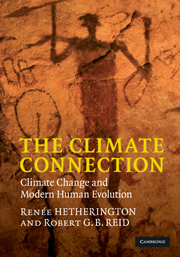Book contents
- Frontmatter
- Contents
- Foreword
- Preface
- Acknowledgements
- 1 Introduction
- Part I Early human history
- Part II Climate during the last glacial cycle
- 5 Climate change over the last 135,000 years
- 6 The effect of 135,000 years of changing climate on the global landscape
- Part III The interaction between climate and humans
- Appendices: The biological background to the story of evolution
- References
- Index
- Plate section
6 - The effect of 135,000 years of changing climate on the global landscape
Published online by Cambridge University Press: 05 August 2012
- Frontmatter
- Contents
- Foreword
- Preface
- Acknowledgements
- 1 Introduction
- Part I Early human history
- Part II Climate during the last glacial cycle
- 5 Climate change over the last 135,000 years
- 6 The effect of 135,000 years of changing climate on the global landscape
- Part III The interaction between climate and humans
- Appendices: The biological background to the story of evolution
- References
- Index
- Plate section
Summary
Introduction
The previous chapter provided a general review of the changing climate on Earth during, and subsequent to, the last but one glacial maximum. We reviewed proxy evidence and climate model simulations, particularly focusing on a recently completed 122,000-year transient or time-series simulation prepared for this book. In this chapter we examine the impact of that changing climate on the landscapes in which early humans lived and subsequently migrated. Of particular interest are the effects on vegetation. Vegetation provides fodder that promotes game populations and various vegetable, fruit and cereal crops for humans. Its absence implies deserts that can act as barriers to habitation and migration.
In this chapter we again use proxy evidence combined with UVic Earth system climate model (UVic ESCM) simulation results, particularly the 122,000-year time series, to ascertain changing vegetation over the LGC. The UVic ESCM consists of a three-dimensional (3D) ocean general circulation model coupled to a dynamic–thermodynamic sea-ice model, an ocean carbon-cycle model, a dynamic energy-moisture balance atmosphere model, a land-surface model and a terrestrial vegetation and carbon-cycle model (Ewen et al., 2003; Matthews, Weaver, Eby et al., 2003; Matthews, Weaver, Meissner et al., 2003; Meissner et al., 2003; Weaver et al., 2001). As stated in the previous chapter, we also included changing land-ice extent and thickness in model simulations.
The coupled vegetation component of the model defines the terrestrial biosphere in terms of soil carbon, five plant functional types (PFTs) and barren ground.
- Type
- Chapter
- Information
- The Climate ConnectionClimate Change and Modern Human Evolution, pp. 175 - 208Publisher: Cambridge University PressPrint publication year: 2010



